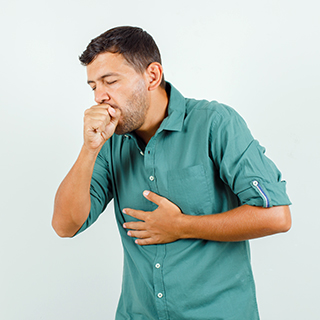
What is Haemoptysis?
Haemoptysis is referred to the coughing up of blood or blood-stained mucus that originates from the bronchi, trachea, larynx or lungs. This can be due to lung cancer or other infections that include bronchitis, tuberculosis, pneumonia and other cardiovascular conditions. It can lead to serious medical conditions and also be life-threatening.
Haemoptysis is usually defined into three types depending on the amount of blood the patient coughs up over a span of 24 hours. The divisions are non-life-threatening or non-massive haemoptysis, life-threatening or massive haemoptysis and scant or mild haemoptysis.
There are several reasons that may lead to haemoptysis, such as lung cancer, chronic obstructive pulmonary disease, damaged airways, parasitic infection and more. Haemoptysis can be diagnosed through coagulation tests, blood chemistry profile, complete blood count, bronchoscopy, CT scan, pulse oximetry, urinalysis and more. Treatment may include laser therapies, surgeries, steroids, radiation or chemotherapy, lung transplant or removal, argon plasma coagulation, embolization, cryotherapy and such others.
What are the symptoms of Haemoptysis?
The most common symptoms of Haemoptysis are –
- Blood in mucus
- Soaking sweats at night
- Chest pain
- Shortness of breath
- Weight loss
- Fever higher than 101 degrees
Who are more predisposed?
Gender – Both male and female smokers are likely to suffer from haemoptysis then non-smokers. Women smokers have reported having a higher death rate due to haemoptysis than men
Age – Adults and older adults are more prone to suffer from haemoptysis owing to their habit of excessive smoking and an unbalanced lifestyle.
Pre-existing diseases – People with pre-existing diseases like chronic obstructive pulmonary disease, lung abscess, mitral valve stenosis, tuberculosis, pulmonary embolism, parasitic infection, pneumonia, cystic fibrosis, lung cancer, trauma to the chest, granulomatosis with polyangiitis, congestive heart failure, non-cancerous lung tumours, Hughes-Stovin syndrome, pulmonary arteriovenous malformations (AVMs), inflammatory autoimmune conditions such as Churg-Strauss syndrome, microscopic polyangiitis, Goodpasture disease, Behcet disease and more), Sarcoidosis, hereditary hemorrhagic telangiectasia, endometriosis and more. Individuals using blood thinners, crack cocaine, foreign objects in airways and have suffered an injury like a car accident or a gunshot are likely to be affected by haemoptysis.
How Dr. Amitabha Saha treats haemoptysis?
Dr. Amitabha Saha is trained in treating Haemoptysis (blood-stained mucus). His process involves an analysis of the symptoms, evaluation of the severity of the disease, medical tests to confirm the condition and spread of the disease, surgery (if required), counselling and medication.
